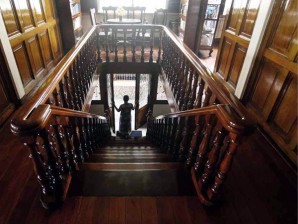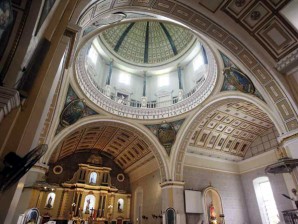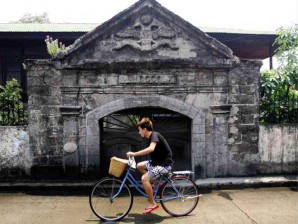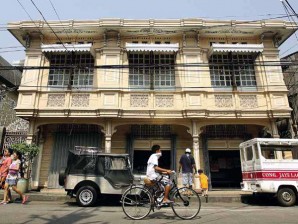Floods can’t stop Malabon from polishing tourism gems

STEP INTO THE PAST Visitors to the Borja house on Gen. A. Luna street are assured of a grand entrance. MARIANNE BERMUDEZ
There is more to Malabon City than the tasty pansit and the floods.
This is the message of the local government as it invites tourists to rediscover the city that grew around a “visita” or chapel when founded by Augustinian friars in 1599.
Pastora Ursal, officer in charge of the Malabon Tourism Office, said even some residents may still be unaware of the city’s “hidden gems” like well-preserved houses, centuries-old churches, art galleries, a zoo, cottage industries and food shops offering Malabonian delicacies.
“Some of them even go as far as Vigan (in the northern province of Ilocos Sur) to see heritage houses. Why go there when we have lots of them here? They also go to Manila just to see a zoo when we have our own,” Ursal told the Inquirer.
Earlier this year, the tourism office met with tour operators and showed them around Malabon, particularly on C. Arellano and Gen. A. Luna streets where most of the heritage houses and old churches are located, and the small factories that produce siomai (Chinese dim sum), weighing scales and condiments like patis and toyo. The initial plan is to convince schools to include Malabon as part of their itinerary for student field trips.
Article continues after this advertisement
A SLICE OF THE RENAISSANCE The ornate dome and ceiling bring worshippers to an elevated state inside San Bartolome Parish.
But long before this City Hall initiative, some residents have been hosting small-group tours for curious visitors over the past few years. Among them are architect Richard Tuason-Sanchez Bautista, Terry de Jesus, Monchet Lucas (whose family produces Rufina patis), and Department of Tourism officer Leona Nepomuceno.
Article continues after this advertisementThe tourism office and Bautista’s group recently hosted a media tour, with the Borja House on Luna Street as the first stop.
The house was built in 1924 by spouses Manuel and Leona Borja, who made a fortune from weaving and dressmaking using jusi and sinamay fabric. Their granddaughter, Dra. Zenaida Borja-Gonzales, said the house had seen little changes through the years.
Party house
“Most of the original furniture and fixtures are still here. My grandfather loved to party so we had a long dining table. He would usher his friends into the dining area, and when they finish eating they were led to the spacious living room so that a new group could sit,” she said.
A family of meticulous caretakers starts the day “just before dawn, when they open all the windows for dusting, and then wax and polish the floor using coconut husk (bunot).”

THE GATE of the Raymundo house, standing since in 1861. PHOTO BY MARIANNE BERMUDEZ
Every three years, the Borja house undergoes repairs and gets a fresh coat of paint and varnish. “That’s the most expensive part. Last time, because we had to replace the roof, we spent about P900,000 for the maintenance job,” she recalled.
Also on Luna Street, the Paez-Gonzalez house built in 1877 has survived thanks to “flood-proofing” measures: the flooring is now about three feet above street level and a garden pond collects rainwater as part of the drainage system.
There is also an old tale in the community saying that Dr. Jose Rizal, the national hero, once saw a patient at the Paez-Gonzalez house to perform an eye surgery.
Another, much-older manor, the Raymundo house, sits along the banks of the Malabon-Navotas River and faces Arellano Street. An adobe gateway bears a Hapsburg Eagle carving and markings that trace its construction to 1861.
Its current owners, Hilarion Raymundo Corvera Jr. (the fifth-generation descendant of the original builders) and his wife Marie Susan said they had taken particular care of the house’s yakal and narra flooring.
The Corveras still find the house in good condition and very cozy at 152 years old, but have apparently accepted the modern-day reality of flooding which inundates their “silong” (ground-floor storage) whenever the river swells during high tide.
Transformations

THE BORJA house hosts a pharmacy on the ground floor while offering pieces of history in every corner. PHOTO BY MARIANNE BERMUDEZ
Another old-timer on Arellano Street, the Martinez house had undergone two transformations before returning to its original purpose. It was once turned into a tobacco factory and later into the headquarters of one of the first deep-sea fishing companies in the country, according to Lucas.
Now owned by Leona Nepomuceno, the house still bears vivid reminders of that maritime period, with its walls adorned with paintings of boats and seascapes. Visitors are asked to remove their shoes and just wear socks or slippers if they want to tour the house.
“There was a time when dances were regularly held here,” Lucas said, referring to the spacious hall.
Malabon also boasts of two centuries-old Augustinian churches: the Immaculate Conception Parish in Barangay Concepcion which was built in 1886, and San Bartolome Parish on Rizal Avenue which was built in 1614.
Their original designs, however, may now be lost due to the renovations made through the years. Immaculate Concepcion curator Paulo Magnali said major repairs were done in the 1990s, for example, when a section of the old roof collapsed.
The altar was also renovated close to the original, large paintings depicting the life of Virgin Mary were mounted on the ceiling, plaster was applied on the walls and the original Machuca tiles were also replaced.
At San Bartolome, the church was also given a makeover after the current parish priest, Fr. Ricardo Torrefiel, discovered that the wooden trusses were already weak and the dome had sustained some damage after a storm.
Quite bare and close to the simple, neoclassical style before the renovation, the church is now more ornate with fiberglass trimmings and art works. To solve the flooding problem, the patio is being raised from the street level and a pump to drain water from the church interior will soon be installed, according to Torrefiel.
Cacnio gallery
In Barangay Hulong Duhat, tourists may check out the art gallery of 82-year-old Angel Cacnio and his Sining Tambobong group.
The artist and longtime Malabon resident could have been a fisherman, he said, but his father found him “too skinny” for the job so he ended up studying fine arts at the University of the Philippines.
Still, fishing and other rustic scenes remained a constant subject in his canvas. “I have always tried to depict our Filipino culture, like the bulungan or when you whisper your price to a fish vendor in the market; cockfights, Filipino versions of Madonna and Child, tribal customs,” he said.
Cacnio’s enduring works also include the design of peso bills, particularly for the P20 and P100 notes that precede the latest editions released in 2010.
According to Ursal, the proposed tour package would include stops at Malabon’s more popular food shops like Dolor’s Kakanin, Nanay’s Pansit Malabon, Betsy’s Cake Center, and Kalbogers which churns out “10-inch hamburgers.”
“We also hope to develop a museum in one of those heritage houses, where people can learn about the history of the city and the other interesting things we have to offer,” she said. “We hope it will erase the perception that Malabon is just a city that is always flooded. We are definitely more than that.”
PHOTO BY MARIANNE BERMUDEZ